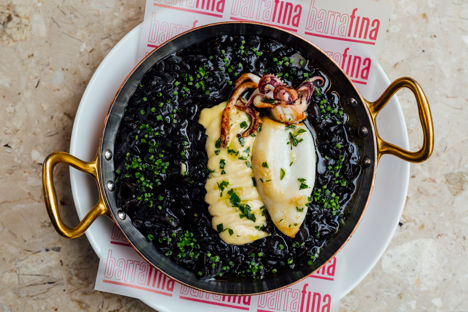
5 spooky squid ink recipes for Halloween
Aside from giving a dramatic black hue to proceedings, squid ink’s natural salinity and unique flavour really makes dishes stand out from the crowd. Here are five of our favourite squid ink recipes from our esteemed chefs and food writers.
5 spooky squid ink recipes for Halloween
Aside from giving a dramatic black hue to proceedings, squid ink’s natural salinity and unique flavour really makes dishes stand out from the crowd. Here are five of our favourite squid ink recipes from our esteemed chefs and food writers.
The excitement of cooking with squid ink comes primarily from its colour. Stir the tiniest amount through a gently bubbling risotto, and the ink conquers every last grain of rice, liberating the pan from its pale, caramelised hues and turning the contents black as night. You can use squid ink to bring spooky black tones to lots of things, from pasta and bread to sauces, but squid ink is so much more than just food colouring – it has a unique briny flavour that goes perfectly with other fish and seafood. If you can buy whole squid, keep an eye out for the silvery ink sacs when you’re cleaning it out, or alternatively, you can buy squid ink online, or from your local fishmonger.
We’ve pulled together five fantastic squid ink recipes from some of our favourite chefs and food writers. For more inspiration, check out our full collection of squid ink recipes!
1. Arròs negre – squid ink rice
As executive chef of the Barrafina group of restaurants in London, Angel Zapata Martin is a guiding light when it comes to next-level Spanish tapas in the UK, and his stunning arròs negre is an ever-popular dish on the menu. Angel sautés diced cuttlefish and spring onion, then toasts the rice before gently cooking in sherry, squid ink and shellfish bisque. The result is a rich rice dish, where the salinity of the squid ink marries perfectly with the sautéed baby squid and punchy all i oli served on top.
2. King crab with squid ink garganelle
There’s something immensely pleasurable about making squid ink pasta, watching your ingredients transform from a floury mess into a gorgeous ball of black dough. Remember to rest the dough after you’ve made it, then roll it out until 3mm in thickness. Cut it into 4cm squares before rolling your garganelli (or you can create a simpler tagliatelle or fettuccine if preferred). Meanwhile, Luke Holder cooks his crab in plenty of salted water, then cools it before picking the meat and stirring it through melted butter. Just add a touch of seasoning and some herbs, and you’re ready for the table.
3. Beetroot hummus with gluten-free squid ink flatbread
Victoria Glass combines two ingredients that are known for their colour in this striking recipe. Her beetroot hummus is dead simple, she just boils a beetroot and blitzes it with chickpeas, tahini, garlic and lemon to make a magenta dip. For the flatbreads, she pulses all her dry ingredients together in a food processor before adding the wet ingredients, squid ink included, and bringing together the dough. Leave the dough somewhere warm to rise, then roll out the flatbreads and fry quickly in a hot pan before serving. Maybe avoid wearing any white clothes for this one.
4. Portland crab with chargrilled pineapple, coconut and cashew nut
Richard Davies' highly technical dish takes the classic pairing of crab and squid ink, but adds some left field exotic elements with the pineapple, coconut and cashew. The squid ink element of the dish comes in a clever little tapioca cracker – Richard cooks his tapioca pearls and mixes them with squid ink, leaving the cracker to dry overnight. To plate, he makes a layer of white crab salad, sits a circle of pineapple jelly over the top, and decorates with spiced pineapple, candied coconut, burnt coconut and the squid ink cracker. Very challenging but hugely impressive.
5. Baked bream with wilted spinach, radish and nero sauce
Colin McGurran’s nero sauce is a fantastic recipe to have stored away for any fish dish. To make his sauce, Colin cooks down shallots with thyme, bay leaf and Noilly Prat, and reduces the mixture before adding fish stock and double cream. Once the sauce reaches coating consistency, he adds the squid ink and blitzes in a food processor before passing through damp muslin. The result is a jet black sauce with a beautiful sheen – perfect alongside Colin’s salt-baked bream.
Get in touch
Please sign in or register to send a comment to Great British Chefs.


